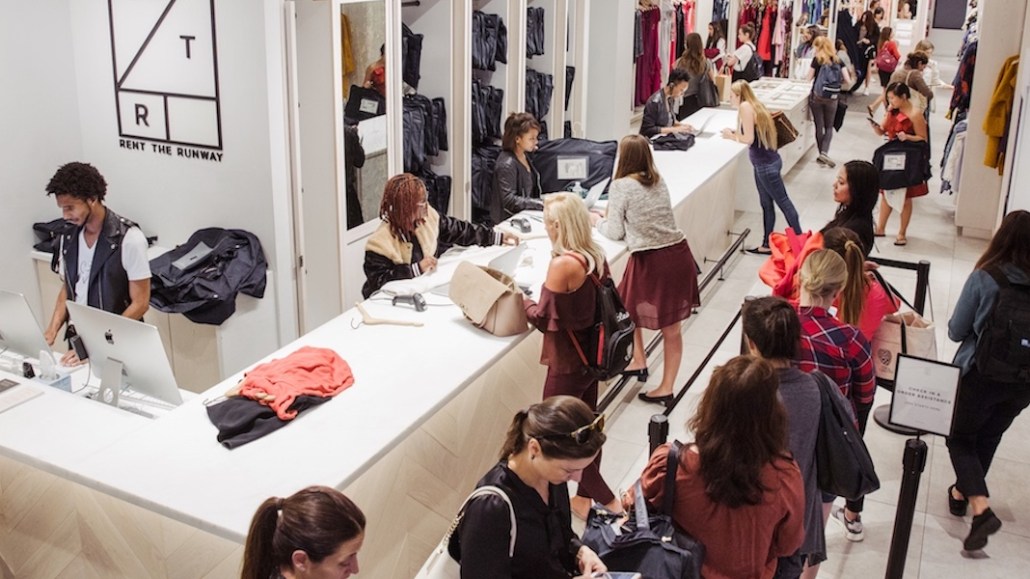Live from NRF: How Rent the Runway’s Unlimited subscription model changed its in-store strategy

When Rent the Runway launched the company’s Unlimited program, a monthly subscription that lets customers pay $159 per month to rent out four items of clothing at a time, the in-store experience didn’t play a big role in the business model.
“Our stores started as showrooms for nice dresses. Almost two years ago, we launched Unlimited. Then that was enabled in stores to let people exchange what they wanted for the next order, and that put a lot of pressure on our stores,” said Hampton Catlin, senior director of engineering at Rent the Runway. “We weren’t prepared for how many people would want to use it in stores. We’ve been investing in tech that lets you rapidly check out, self-service, so people can get in and out.”
In partnership with technology company Aila, Rent the Runway is transforming its stores from showrooms for rental items to logistical hubs for Unlimited subscribers to drop off items and check out new ones, all through self-service tablets.
Catlin joined us for an episode of the Glossy Podcast, recorded live at the National Retail Federation’s Big Show conference in New York, to discuss what role the store plays in the sharing economy, why convincing customers to rent instead of buy isn’t bad for brands and why customers are happy to hand over information.
Edited highlights, below.
On in-store inventory:
Part of making its stores as convenient as possible for Unlimited subscribers includes ensuring that the inventory that’s stocked in stores is relevant to the customers who visit. This means using customer data, combined with stylist insight, to choose inventory. But figuring out how personalized a store’s merchandise can be is part of the challenge. What’s in store at a Rent the Runway location on the Upper East Side should be different than what’s in the Flatiron store, but nailing down the difference is still a work in progress.”
“This is an area where we’re still figuring it out,” said Catlin. “We have the data and machine-learning algorithms, but what we haven’t exactly figured out yet is the scale of that personalization. If we want to fill a store with things that people in a certain neighborhood like, how micro can we get? Wherever we decide where to hold inventory, that’s costing us money.”
On customer data:
Customer data is central to Rent the Runway’s store strategy, whether it’s determining what’s stocked in a certain store location or what the mobile app looks like when an Unlimited member walks in. And a lot of that data is sourced directly from customers themselves.
“Our customers give us a lot of information about themselves — they’re happy to,” said Catlin. “They review, rate, post pictures. It becomes a community feeling, especially with the subscription business.”
On brand relationships:
While Rent the Runway shares customer data back with the brands it works with, the company is training customers that, rather than buy, they can rent. That has to be bad for brands, right? Catlin argues that’s not the case, due to the type of inventory Rent the Runway buys from brands. In most cases, it’s the louder, bolder pieces that subscribers gravitate toward, since they’re not investing in the items long-term. And according to Catlin, Rent the Runway’s physical stores further promote risk-taking.
“Most high-end brands make their money off extra licensing, stuff like that — not from the clothing itself,” said Catlin. “Fast fashion companies that rip off what designers do, very quickly — those are the companies that are actually hurting the designers. We buy stuff from designers in volumes they are not used to selling. And we’ve noticed people will take much bigger risks in real life than they will when shopping online.”
More in Marketing

Zero-click search is changing how small brands show up online — and spend
To appease the AI powers that be, brands are prioritizing things like blogs, brand content and landing pages.

More creators, less money: Creator economy expansion leaves mid-tier creators behind
As brands get pickier and budgets tighten, mid-tier creators are finding fewer deals in the booming influencer economy.

‘Still not a top tier ad platform’: Advertisers on Linda Yaccarino’s departure as CEO of X
Linda Yaccarino — the CEO who was never really in charge.









